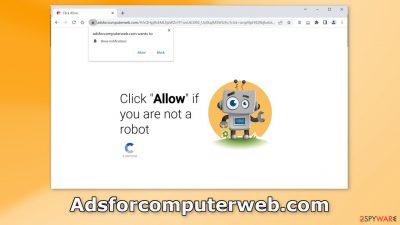Adsforcomputerweb.com ads (spam) - Free Instructions
Adsforcomputerweb.com ads Removal Guide
What is Adsforcomputerweb.com ads?
Adsforcomputerweb.com tries to get users to click “Allow” to subscribe to push notifications

Adsforcomputerweb.com tries to trick people into thinking that they need to confirm that they are not robots to access the content on the site. In reality, there is no other content to explore besides the deceptive message. Crooks that created this page use social engineering methods[1] to make people click on the “Allow” button.
Once that happens, users become subscribed to push notifications. They start getting spammed with annoying pop-up ads that can appear even when the browser is closed. Fraudsters may use rogue advertising networks that place ads leading to dangerous websites.
By clicking on the attached links, people can end up on scam pages that try to lure out personal information, and make users download PUPs (potentially unwanted programs)[2] or malware unknowingly. Many affected by pop-up spam report seeing ads promoting adult sites, fake antivirus offers, software deals, surveys, giveaways, etc.
| NAME | Adsforcomputerweb.com |
| TYPE | Push notification spam; adware |
| SYMPTOMS | Pop-up ads start appearing in the corner of the screen sometimes even when the browser is closed |
| DISTRIBUTION | Shady websites; deceptive ads; freeware installations |
| DANGERS | The pop-ups can expose people to inappropriate content like adult, gambling sites, and even scams |
| ELIMINATION | To eliminate push notifications go to your browser settings |
| FURTHER STEPS | Use FortectIntego to clear your browsers and fix performance issues |
Distribution methods
To avoid websites like Adsforcomputerweb.com in the future, you should not browse through shady sites. Pages that engage in illegal activities are unregulated so they are full of deceptive ads and sneaky redirects. We especially do not recommend using illegal streaming sites because they can display fake “Download” and “Play” buttons[3] that can lead to pop-up spam sites.
Visit websites that you know and trust. Do not click on random links and ads. Even if the advertisements seem to be promoting legitimate products or services, it is best to go to the source directly. Another possibility is that the page appeared without any user input.
This can happen if there is adware hiding in your machine. It is advertising-supported software that can cause an increased amount of commercial content, like pop-ups, banners, and redirects. Depending on the type of infection, different removal methods may apply.

Disable the notifications
If you have had enough of annoying ads, you can disable Adsforcomputerweb.com permissions to show pop-ups by going to your browser settings. Keep in mind that this might not work if you have an adware infection. After successful removal, you need to take care of your browsers separately.
Google Chrome (desktop):
- Open Google Chrome browser and go to Menu > Settings.
- Scroll down and click on Advanced.
- Locate the Privacy and security section and pick Site Settings > Notifications.
![Stop notifications on Chrome PC 1 Stop notifications on Chrome PC 1]()
- Look at the Allow section and look for a suspicious URL.
- Click the three vertical dots next to it and pick Block. This should remove unwanted notifications from Google Chrome.
![Stop notifications on Chrome PC 2 Stop notifications on Chrome PC 2]()
Google Chrome (Android):
- Open Google Chrome and tap on Settings (three vertical dots).
- Select Notifications.
- Scroll down to Sites section.
- Locate the unwanted URL and toggle the button to the left (Off setting).
![Stop notifications on Chrome Android Stop notifications on Chrome Android]()
Mozilla Firefox:
- Open Mozilla Firefox and go to Menu > Options.
- Click on Privacy & Security section.
- Under Permissions, you should be able to see Notifications. Click Settings button next to it.
![Stop notifications on Mozilla Firefox 1 Stop notifications on Mozilla Firefox 1]()
- In the Settings – Notification Permissions window, click on the drop-down menu by the URL in question.
- Select Block and then click on Save Changes. This should remove unwanted notifications from Mozilla Firefox.
![Stop notifications on Mozilla Firefox 2 Stop notifications on Mozilla Firefox 2]()
Safari:
- Click on Safari > Preferences…
- Go to Websites tab and, under General, select Notifications.
- Select the web address in question, click the drop-down menu and select Deny.
![Stop notifications on Safari Stop notifications on Safari]()
MS Edge:
- Open Microsoft Edge, and click the Settings and more button (three horizontal dots) at the top-right of the window.
- Select Settings and then go to Advanced.
- Under Website permissions, pick Manage permissions and select the URL in question.
![Stop notifications on Edge 1 Stop notifications on Edge 1]()
- Toggle the switch to the left to turn notifications off on Microsoft Edge.
![Stop notifications on Edge 2 Stop notifications on Edge 2]()
MS Edge (Chromium):
- Open Microsoft Edge, and go to Settings.
- Select Site permissions.
- Go to Notifications on the right.
- Under Allow, you will find the unwanted entry.
- Click on More actions and select Block.
![Stop notifications on Edge Chromium Stop notifications on Edge Chromium]()
Clear your browsers from cookies
With the help of cookies, shady websites you visit can collect data about your browsing activities. This includes your IP address, geolocation, links you click on, and things you purchase online. This information can later be sold to advertising networks or other third parties for profit.
You should clear your browsers from cookies and cache regularly, to prevent that from happening. Using a maintenance tool like FortectIntego makes it easy. This powerful software can also fix various system errors, corrupted files, and registry issues, which is especially helpful after a virus infection.
Adware removal
If the previous removal method did not work and you still experience symptoms like an increased amount of commercial content, banners, surveys, or redirects you might be infected by adware. These programs often infiltrate the systems as bundled software from freeware distribution sites.
To avoid this, you should always choose the “Custom” or “Advanced” installation methods, read the Privacy Policy, and Terms of Use to find out more information about the program. The most important thing is to check the file list and untick the boxes next to any unrelated files.
If you have no idea which app is responsible for such activities, you should deploy SpyHunter 5Combo Cleaner or Malwarebytes professional security software that will perform a full system scan and eliminate it automatically. They can also prevent such infections in the future by warning you. If you still prefer doing it yourself, here are step-by-step instructions for Windows and macOS:
Instructions for Windows 10/8 machines:
- Enter Control Panel into Windows search box and hit Enter or click on the search result.
- Under Programs, select Uninstall a program.
![Uninstall from Windows 1 Uninstall from Windows 1]()
- From the list, find the entry of the suspicious program.
- Right-click on the application and select Uninstall.
- If User Account Control shows up, click Yes.
- Wait till uninstallation process is complete and click OK.
![Uninstall from Windows 2 Uninstall from Windows 2]()
Windows 7/XP:
- Click on Windows Start > Control Panel located on the right pane (if you are Windows XP user, click on Add/Remove Programs).
- In Control Panel, select Programs > Uninstall a program.
![Uninstall from Windows 7/XP Uninstall from Windows 7/XP]()
- Pick the unwanted application by clicking on it once.
- At the top, click Uninstall/Change.
- In the confirmation prompt, pick Yes.
- Click OK once the removal process is finished.
For macOS users:
- From the menu bar, select Go > Applications.
- In the Applications folder, look for all related entries.
- Click on the app and drag it to Trash (or right-click and pick Move to Trash)
![Uninstall from Mac 1 Uninstall from Mac 1]()
To fully remove an unwanted app, you need to access Application Support, LaunchAgents, and LaunchDaemons folders and delete relevant files:
- Select Go > Go to Folder.
- Enter /Library/Application Support and click Go or press Enter.
- In the Application Support folder, look for any dubious entries and then delete them.
- Now enter /Library/LaunchAgents and /Library/LaunchDaemons folders the same way and terminate all the related .plist files.
![Uninstall from Mac 2 Uninstall from Mac 2]()
How to prevent from getting adware
Access your website securely from any location
When you work on the domain, site, blog, or different project that requires constant management, content creation, or coding, you may need to connect to the server and content management service more often. The best solution for creating a tighter network could be a dedicated/fixed IP address.
If you make your IP address static and set to your device, you can connect to the CMS from any location and do not create any additional issues for the server or network manager that needs to monitor connections and activities. VPN software providers like Private Internet Access can help you with such settings and offer the option to control the online reputation and manage projects easily from any part of the world.
Recover files after data-affecting malware attacks
While much of the data can be accidentally deleted due to various reasons, malware is one of the main culprits that can cause loss of pictures, documents, videos, and other important files. More serious malware infections lead to significant data loss when your documents, system files, and images get encrypted. In particular, ransomware is is a type of malware that focuses on such functions, so your files become useless without an ability to access them.
Even though there is little to no possibility to recover after file-locking threats, some applications have features for data recovery in the system. In some cases, Data Recovery Pro can also help to recover at least some portion of your data after data-locking virus infection or general cyber infection.
- ^ Cynthia Gonzalez. Top 8 Social Engineering Techniques and How to Prevent Them [2022]. Exabeam. Information Security.
- ^ Wendy Zamora. What is a PUP? – How to avoid potentially unwanted programs. Malwarebytes. Cybersecurity Blog.
- ^ Andy Maxwell. Google Targets Fake ‘Download’ and ‘Play’ Buttons. Torrentfreak. Filesharing News.














